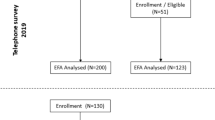Abstract
Introduction: This study was designed to explore the psychosocial aspects of injured workers, their self-perceived capacity and how these factors influence their success in Return To Work (RTW). Method: Seventy-five subjects were recruited from the Hong Kong Workers’ Health Centre and were assessed on three occasions consisting of interviews and four self-rated instruments including the Chinese Lam’s Assessment of Employment Readiness (C-LASER), the SF-36 health survey, the Chinese State Trait and the Anxiety Inventory (C-STAI). Results: Results showed that the contemplation and pre-contemplation sub-scores of C-LASER appeared to be the determining factors in predicting subjects’ return-to-work status. Subjects who were more “ready for action” (the Actioners) were found to have significantly higher confidence and advocacy in job seeking than the Pre-Contemplators. Their employment readiness was shown to be affected by psychosocial factors such as perceived functioning and bodily pain, Discussion: From this study, the injured workers’ employment readiness appeared to associate with their RTW outcomes. Further studies would be needed to find out how the employment readiness of injured workers could be enhanced.
Similar content being viewed by others
References
Wassel ML. Improving return to work outcomes. AAOHN 2002;50:278–85.
Ford LH, Sweet EA. Job Placement and rehabilitation counselors in the State-Federal System. Rehabil Couns Bull 1999;42:354–65.
Chan CCH, Li WPC, Hung LK, Lam CW. A standardized clinical series for work-related lateral epicondylitis. J Occup Rehabil 1999;10:143–52.
Sullivan MJL, Feuerstein M, Gatchel R, Linton SJ, Pransky G. Integrating psychosocial and behaviorial interventions to acheive optimal rehabilitation outcomes. J Occup Rehabil 2005;15:475–89
Feuerstein M, Nicholas RA, Huang GD, Dimberg L, Ali D, Rogers H. Job stress management and ergonmic intervention for work-related upper extremity symptoms. Appl Ergon 2004;35:565–74.
Oleske DM, Andersson GBJ, Lavender SA, Hahn JJ. Association between recovery outcomes for work-related low back disorders and personal, family, and work factors. Spine 2000;25:1259–65.
Bongers MP, Winter CR, Kompier MAJ, Hildebrandt VH. Psychosocial factors at work and musculoskeletal disease. Scand J Work Environ Health 1993;19:297–312.
Prochaska JO, DiClemente CC, Norcross JC. In search of how people change: Applications to addictive behaviors. Am Psychol 1992;47:1102–14.
Lam C. A conceptual model for service delivery to people who are unemployed (Unpublished manuscript). Illinois Institute of Technology 1997.
Franche RL, Krause N. Readiness for return to work following injury or illness: conceptualizing the interpersonal impact of health care, workplace, and insurance factors. J Occup Rehabil 2002;17:233–56.
Geisser ME, Roth RS. Knowledge of and agreement with chronic pain disgonosis: Relation to affective distress, pain beliefs and coping, pain intensity, and disability. J Occup Rehabil 1998;8(1):73–88
Matheson LN, Matheson ML. Performance assessment and capacity testing spinal function sort: Rating of perceived capacity. Wildwood, MO: Employment Potential Improvement Corporation; 1993.
Matheson LN, Matheson ML. Examiner’s Manual for the Spinal Function Sort. EPIC 2000.
Matheson LN, Matheson ML, Grant J. Development of a measure of perceived functional ability. J Occup Rehabil 1993;3(1):15–30.
West Evaluation Systems Technology. LLUMC Activity Sort 1986.
Chan HHK, Li-Tsang CWP, Chan CCH, Lam CS, Hui YL, Bard CC. Validation of Chinese Lam Assessment of Employment Readiness (C-LASER) for Chinese Injured Workers. The Hong Kong Polytechnic University 2006.
Shek DTL. The chinese version of the state-trait anxiety inventory: It’s Relationship to different measures of psychological well-being. J Clin Psychol 1993;49:349–58.
Shek DTL. The factorial structure of the Chinese version of the state-trait anxiety inventory: A confirmatory factor analysis. Educ Psychol Meas 1991;51:985–98.
Lam CL, Gandek B, Ren XS, Chan MS. Tests of scaling assumptions and construct validity of the Chinese (HK) version of the SF-36 health survey. J Clin Epidemiol 1998;51:1139–47.
Gibson L, Strong J. The reliability and validity of a measure of perceived functional capacity for work in chronic back pain. J Occup Rehabil 1996;6:159–75.
Gatchel RJ, Adams L, Polatin PB, Kishino ND. Secondary loss and pain-associated disability: theoretical overview and treatment implications. J Occup Rehabil 2002;12:99–110.
Melles T, McIntotosh G, Hall H. Provider, payor, and patient outcome expectations in back pain rehabilitation. J Occup Rehabil 1995;5:57–69.
Acknowledgements
The authors thank Hong Kong Workers’ Health Centre for jointly collaboration of this study, Mr. Yanwen Xu and Mr. Jiaqi Li for their effort on data collection. We would also like to thank all the participants of this project. This study would not have been possible without their support.
Author information
Authors and Affiliations
Corresponding author
Rights and permissions
About this article
Cite this article
Li-Tsang, C.W., Chan, H.H., Lam, C. et al. Psychosocial Aspects of Injured Workers’ Returning to Work (RTW) in Hong Kong. J Occup Rehabil 17, 279–288 (2007). https://doi.org/10.1007/s10926-007-9075-2
Published:
Issue Date:
DOI: https://doi.org/10.1007/s10926-007-9075-2




